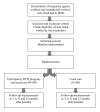Cost-effectiveness of a participatory return-to-work intervention for temporary agency workers and unemployed workers sick-listed due to musculoskeletal disorders: design of a randomised controlled trial
- PMID: 20346183
- PMCID: PMC2858719
- DOI: 10.1186/1471-2474-11-60
Cost-effectiveness of a participatory return-to-work intervention for temporary agency workers and unemployed workers sick-listed due to musculoskeletal disorders: design of a randomised controlled trial
Abstract
Background: Within the working population there is a vulnerable group: workers without an employment contract and workers with a flexible labour market arrangement, e.g. temporary agency workers. In most cases, when sick-listed, these workers have no workplace/employer to return to. Also, for these workers access to occupational health care is limited or even absent in many countries. For this vulnerable working population there is a need for tailor-made occupational health care, including the presence of an actual return-to-work perspective. Therefore, a participatory return-to-work program has been developed based on a successful return-to-work intervention for workers, sick-listed due to low back pain.The objective of this paper is to describe the design of a randomised controlled trial to study the (cost-)effectiveness of this newly developed participatory return-to-work program adapted for temporary agency workers and unemployed workers, sick-listed due to musculoskeletal disorders, compared to usual care.
Methods/design: The design of this study is a randomised controlled trial with one year of follow-up. The study population consists of temporary agency workers and unemployed workers sick-listed between 2 and 8 weeks due to musculoskeletal disorders. The new return-to-work program is a stepwise program aimed at making a consensus-based return-to-work implementation plan with the possibility of a (therapeutic) workplace to return-to-work. Outcomes are measured at baseline, 3, 6, 9 and 12 months. The primary outcome measure is duration of the sickness benefit period after the first day of reporting sick. Secondary outcome measures are: time until first return-to-work, total number of days of sickness benefit during follow-up; functional status; intensity of musculoskeletal pain; pain coping; and attitude, social influence and self-efficacy determinants. Cost-benefit is evaluated from an insurer's perspective. A process evaluation is part of this study.
Discussion: For sick-listed workers without an employment contract there can be gained a lot by improving occupational health care, including return-to-work guidance, and by minimising the 'labour market handicap' by creating a return-to-work perspective. In addition, reduction of sickness absence and work disability, i.e. a reduction of disability claims, may result in substantial benefits for the Dutch Social Security System.
Trial registration number: NTR1047.
Figures
References
-
- Verbeek JH. Vocational rehabilitation for workers with back pain. Scand J Work Environ Health. 2001;27:346–352. - PubMed
-
- Franche RL, Cullen K, Clarke J, Irvin E, Sinclair S, Frank J. The Institute for Work & Health (IWH) Workplace-Based RTW Intervention Literature Review Research Team. Workplace-based return-to-work interventions: a systematic review of the quantitative literature. J Occup Rehabil. 2005;15:607–631. doi: 10.1007/s10926-005-8038-8. - DOI - PubMed
-
- Hlobil H, Staal JB, Spoelstra M, Ariëns GA, Smid T, van Mechelen W. Effectiveness of a return-to-work intervention for subacute low-back pain. Scand J Work Environ Health. 2005;31:249–257. - PubMed
Publication types
MeSH terms
LinkOut - more resources
Full Text Sources
Medical



